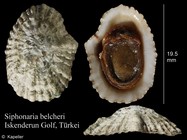MolluscaBase taxon details
Siphonaria belcheri Hanley, 1858
761477 (urn:lsid:marinespecies.org:taxname:761477)
accepted
Species
marine, brackish, fresh, terrestrial
recent only
Hanley, S. (1858). On <i>Siphonaria</i>. <em>Proceedings of the Zoological Society of London.</em> 26: 151–153., available online at http://biodiversitylibrary.org/page/32271649
page(s): 153 [details]
page(s): 153 [details]
MolluscaBase eds. (2025). MolluscaBase. Siphonaria belcheri Hanley, 1858. Accessed at: https://www.molluscabase.org/aphia.php?p=taxdetails&id=761477 on 2025-09-11
![]() The webpage text is licensed under a Creative Commons
Attribution 4.0 License
The webpage text is licensed under a Creative Commons
Attribution 4.0 License
original description
Hanley, S. (1858). On <i>Siphonaria</i>. <em>Proceedings of the Zoological Society of London.</em> 26: 151–153., available online at http://biodiversitylibrary.org/page/32271649
page(s): 153 [details]
additional source Albayrak, S.; Çağlar, S. (2006). On the presence of <i>Siphonaria belcheri</i> Hanley, 1858 [Gastropoda: Siphonariidae] and <i>Septifer bilocularis</i> (Linnaeus, 1758) [Bivalvia: Mytilidae] in the Iskenderun Bay (SE Turkey). <em>Aquatic Invasions.</em> 1(4): 292-294., available online at https://doi.org/10.3391/ai.2006.1.4.15 [details]
additional source Zenetos, A., M.E. Cinar, M.A. Pancucci-Papadopoulou, J.G. Harmelin, G. Furnari, F. Andaloro, N. Bellou, N. Streftaris & H. Zibrowius. (2005). Annotated list of marine alien species in the Mediterranean with records of the worst invasive species. <em>Mediterranean Marine Science.</em> 6 (2): 63-118., available online at https://www.researchgate.net/publication/273213810_Annotated_list_of_marine_alien_species_in_the_Mediterranean_with_records_of_the_worst_invasive_species [details] Available for editors [request]
[request]
subsequent type designation Jenkins, B.; Köhler, F. (2024). Hidden in plain sight: Systematic review of Indo-West Pacific Siphonariidae uncovers extensive cryptic diversity based on comparative morphology and mitochondrial phylogenetics (Mollusca, Gastropoda). <em>Megataxa.</em> 13(1): 1-217., available online at https://doi.org/10.11646/megataxa.13.1.1
page(s): 103 [details] Available for editors [request]
[request]
page(s): 153 [details]
additional source Albayrak, S.; Çağlar, S. (2006). On the presence of <i>Siphonaria belcheri</i> Hanley, 1858 [Gastropoda: Siphonariidae] and <i>Septifer bilocularis</i> (Linnaeus, 1758) [Bivalvia: Mytilidae] in the Iskenderun Bay (SE Turkey). <em>Aquatic Invasions.</em> 1(4): 292-294., available online at https://doi.org/10.3391/ai.2006.1.4.15 [details]
additional source Zenetos, A., M.E. Cinar, M.A. Pancucci-Papadopoulou, J.G. Harmelin, G. Furnari, F. Andaloro, N. Bellou, N. Streftaris & H. Zibrowius. (2005). Annotated list of marine alien species in the Mediterranean with records of the worst invasive species. <em>Mediterranean Marine Science.</em> 6 (2): 63-118., available online at https://www.researchgate.net/publication/273213810_Annotated_list_of_marine_alien_species_in_the_Mediterranean_with_records_of_the_worst_invasive_species [details] Available for editors
subsequent type designation Jenkins, B.; Köhler, F. (2024). Hidden in plain sight: Systematic review of Indo-West Pacific Siphonariidae uncovers extensive cryptic diversity based on comparative morphology and mitochondrial phylogenetics (Mollusca, Gastropoda). <em>Megataxa.</em> 13(1): 1-217., available online at https://doi.org/10.11646/megataxa.13.1.1
page(s): 103 [details] Available for editors
 Present
Present  Inaccurate
Inaccurate  Introduced: alien
Introduced: alien  Containing type locality
Containing type locality




